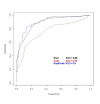Self-ordered pointing and visual conditional associative learning tasks in drug-free schizophrenia spectrum disorder patients
- PMID: 18215296
- PMCID: PMC2245938
- DOI: 10.1186/1471-244X-8-6
Self-ordered pointing and visual conditional associative learning tasks in drug-free schizophrenia spectrum disorder patients
Abstract
Background: There is evidence of a link between schizophrenia and a deficit of working memory, but this has been derived from tasks not specifically developed to probe working memory per se. Our aim was to investigate whether working memory deficits may be detected across different paradigms using the self-ordered pointing task (SOPT) and the visual conditional associative learning task (VCALT) in patients with schizophrenia spectrum disorders and healthy controls. The current literature suggests deficits in schizophrenia spectrum disorder patients versus healthy controls but these studies frequently involved small samples, broad diagnostic criteria, inclusion of patients on antipsychotic medications, and were not controlled for symptom domains, severity of the disorder, etc. To overcome some of these limitations, we investigated the self-monitoring and conditional associative learning abilities of a numerically representative sample of healthy controls and a group of non-deteriorated, drug-free patients hospitalized for a schizophrenia spectrum disorder with florid, mainly positive psychotic symptoms.
Methods: Eighty-five patients with a schizophrenia spectrum disorder (DSM-IV-TR diagnosis of schizophrenia (n = 71) or schizophreniform disorder (n = 14)) and 80 healthy controls entered the study. The clinical picture was dominated by positive symptoms. The healthy control group had a negative personal and family history of schizophrenia or mood disorder and satisfied all the inclusion and exclusion criteria other than variables related to schizophrenia spectrum disorders.
Results: Compared to controls, patients had worse performances on SOPT, VCALT and higher SOPT/VCALT ratios, not affected by demographic or clinical variables. ROC curves showed that SOPT, VCALT, and SOPT/VCALT ratio had good accuracy in discriminating patients from controls. The SOPT and VCALT scores were inter-correlated in controls but not in patients.
Conclusion: The selection of a clinically homogeneous group of patients, controlled for a number of potential confounding factors, and the high level of significance found in the different analyses confirm the presence of SOPT and VCALT abnormalities in a large preponderance of patients with schizophrenia spectrum disorder with positive symptoms. SOPT, VCALT, and SOPT/VCALT ratio showed good accuracy in discriminating patients from healthy controls. These conclusions cannot be extended to schizophrenia spectrum disorder patients with a different clinical profile from our patient population.
Figures
Similar articles
-
Visual processing and neuropsychological function in schizophrenia and schizoaffective disorder.Psychiatry Res. 2002 Aug 30;111(2-3):125-36. doi: 10.1016/s0165-1781(02)00139-7. Psychiatry Res. 2002. PMID: 12374630
-
Organizational strategy use in obsessive-compulsive disorder.Psychiatry Res. 2004 Oct 30;128(3):267-72. doi: 10.1016/j.psychres.2004.04.006. Psychiatry Res. 2004. PMID: 15541784
-
Visuospatial memory and learning in first-episode schizophreniform psychosis and established schizophrenia: a functional correlate of hippocampal pathology?Psychol Med. 2002 Apr;32(3):429-38. doi: 10.1017/s0033291702005275. Psychol Med. 2002. PMID: 11989988
-
Cognitive and psychomotor effects of risperidone in schizophrenia and schizoaffective disorder.Clin Ther. 2008 Sep;30(9):1565-89. doi: 10.1016/j.clinthera.2008.09.014. Clin Ther. 2008. PMID: 18840365 Review.
-
[The schizophrenia spectrum and other psychotic disorders in the DSM-5].Tijdschr Psychiatr. 2014;56(3):167-72. Tijdschr Psychiatr. 2014. PMID: 24643825 Review. Dutch.
Cited by
-
Motivating Persons with Schizophrenia Spectrum Disorders to Exercise: Rationale and Design.Clin Schizophr Relat Psychoses. 2009 Jul 1;3(2):111-116. doi: 10.3371/CSRP.3.2.6. Clin Schizophr Relat Psychoses. 2009. PMID: 20204148 Free PMC article.
-
Effectiveness of Cognitive Remediation in Early Versus Chronic Schizophrenia: A Preliminary Report.Front Psychiatry. 2019 Apr 11;10:236. doi: 10.3389/fpsyt.2019.00236. eCollection 2019. Front Psychiatry. 2019. PMID: 31031662 Free PMC article.
-
Elevated plasma matrix metalloproteinase 9 in schizophrenia patients associated with poor antipsychotic treatment response and white matter density deficits.Schizophrenia (Heidelb). 2024 Aug 27;10(1):71. doi: 10.1038/s41537-024-00494-w. Schizophrenia (Heidelb). 2024. PMID: 39191778 Free PMC article.
-
Informed consent to research in persons with schizophrenia spectrum disorders.Nurs Ethics. 2010 Jul;17(4):425-34. doi: 10.1177/0969733010364581. Nurs Ethics. 2010. PMID: 20610576 Free PMC article. Clinical Trial.
-
Feasibility of the Walk, Address, Learn and Cue (WALC) Intervention for schizophrenia spectrum disorders.Arch Psychiatr Nurs. 2010 Feb;24(1):54-62. doi: 10.1016/j.apnu.2009.03.001. Epub 2009 Aug 6. Arch Psychiatr Nurs. 2010. PMID: 20117689 Free PMC article.
References
Publication types
MeSH terms
LinkOut - more resources
Full Text Sources
Medical



